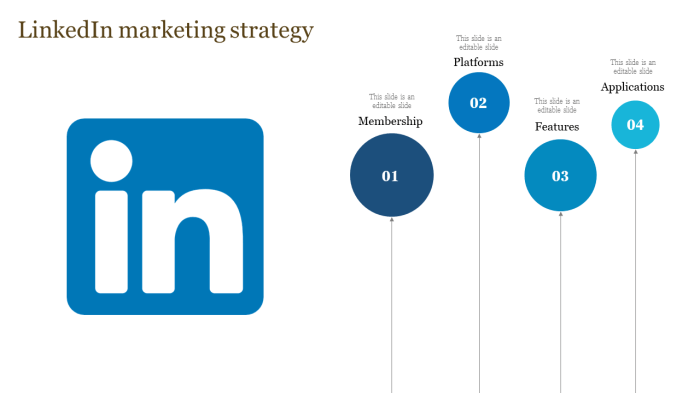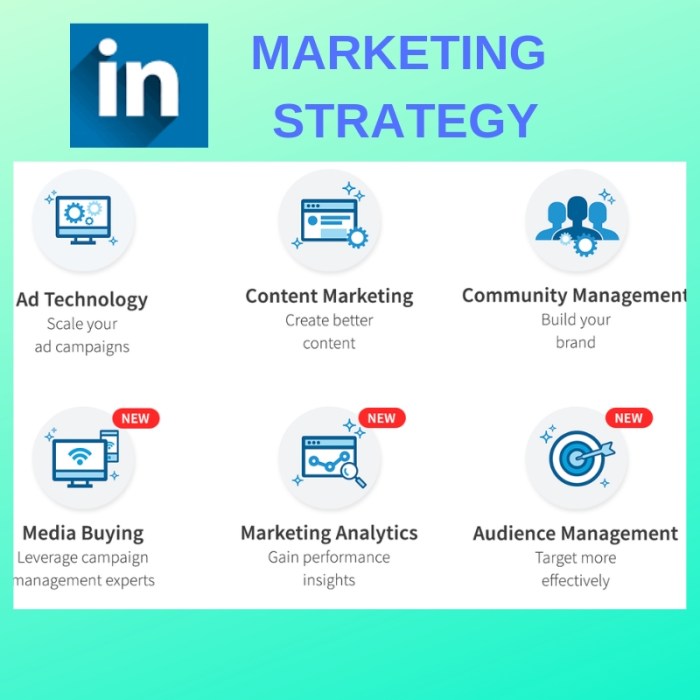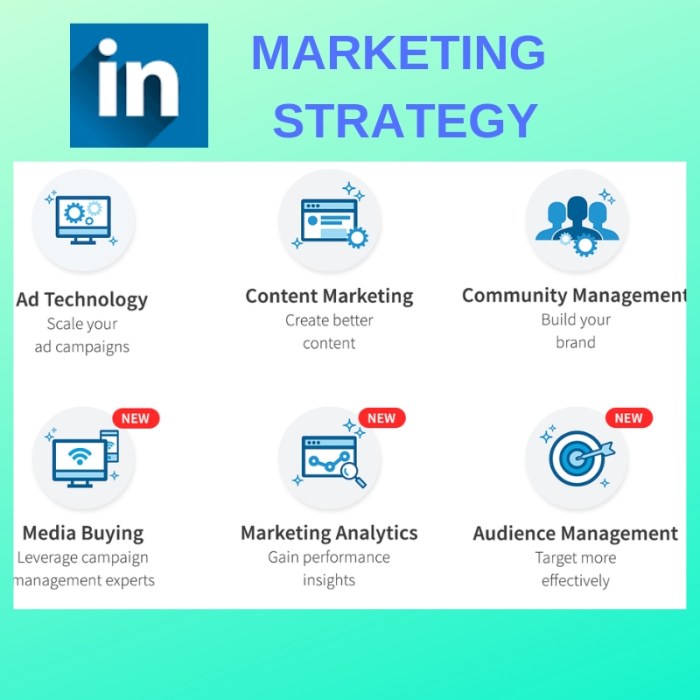Building a LinkedIn Marketing Strategy takes center stage, beckoning readers into a world of strategic networking and engaging content. Dive into the essentials of leveraging LinkedIn for business growth and brand visibility.
Introduction to LinkedIn Marketing Strategy
A LinkedIn marketing strategy is a plan of action formulated to leverage the power of the LinkedIn platform for brand promotion, lead generation, and networking. It involves utilizing various tools and techniques to reach and engage with a target audience on LinkedIn.
Importance of a LinkedIn Marketing Strategy
A well-thought-out LinkedIn marketing strategy is crucial for businesses looking to establish a strong online presence and connect with professionals in their industry. It helps in building brand awareness, generating leads, and fostering relationships with potential clients and partners.
Benefits of Having a Well-Thought-Out LinkedIn Marketing Strategy
- Increased Brand Visibility: By consistently sharing relevant content and engaging with your audience, you can enhance your brand’s visibility on LinkedIn.
- Lead Generation: LinkedIn provides a platform for businesses to generate high-quality leads through targeted advertising and strategic networking.
- Establishing Authority: Sharing valuable insights and industry knowledge can position your brand as an authority in your field, gaining trust and credibility among your audience.
Examples of Successful Companies Utilizing LinkedIn for Marketing Purposes
- Microsoft: Microsoft utilizes LinkedIn for thought leadership content, company updates, and recruitment efforts, effectively engaging with its target audience.
- HubSpot: HubSpot leverages LinkedIn for content marketing, lead generation, and building relationships with industry professionals, showcasing its expertise in marketing automation.
- Adobe: Adobe uses LinkedIn for showcasing customer success stories, promoting webinars, and engaging with its audience through valuable content, driving brand awareness and lead generation.
Setting Goals for LinkedIn Marketing
Setting clear and measurable goals is crucial for a successful LinkedIn marketing strategy. It helps businesses stay focused, track progress, and ultimately achieve their desired outcomes.
Examples of Specific Goals
- Increasing brand awareness by gaining 1000 new followers on LinkedIn within the next six months.
- Generating leads by driving 500 clicks to the company website from LinkedIn posts in the next quarter.
- Boosting engagement by increasing the average likes and comments on posts by 25% in the next month.
Aligning LinkedIn Marketing Goals with Business Objectives
Aligning LinkedIn marketing goals with overall business objectives ensures that efforts are contributing directly to the company’s success. Here are some steps to achieve alignment:
- Evaluate the company’s current goals and objectives to identify areas where LinkedIn marketing can support them.
- Create LinkedIn marketing goals that directly tie into the broader business objectives, such as increasing sales, expanding reach, or building customer relationships.
- Regularly review and adjust LinkedIn marketing goals to ensure they remain aligned with the evolving needs of the business.
Target Audience Identification on LinkedIn
Identifying and understanding your target audience on LinkedIn is crucial for the success of your marketing strategy. This process involves analyzing demographics, interests, behaviors, and preferences of potential customers on the platform.
Leveraging LinkedIn Analytics and Insights
Utilize LinkedIn analytics to gain valuable insights into your audience demographics, such as age, location, industry, job title, and company size. This data can help you tailor your content to better resonate with your target audience.
- Use LinkedIn Analytics to track engagement metrics like views, likes, comments, and shares to understand what type of content is resonating with your audience.
- Identify the peak times when your audience is most active on LinkedIn to optimize the timing of your posts for maximum visibility.
- Utilize LinkedIn’s Audience Insights tool to gain a deeper understanding of your audience’s interests, behaviors, and preferences.
Tailoring Content for Your Audience
To effectively engage with your target audience on LinkedIn, it’s essential to tailor your content to their preferences and interests.
- Create content that addresses the pain points and challenges of your target audience, offering valuable solutions and insights.
- Use language and tone that resonates with your audience, whether they are industry professionals, decision-makers, or entry-level employees.
- Personalize your messages and content to make your audience feel valued and understood, increasing engagement and trust.
Content Strategy for LinkedIn Marketing

When it comes to creating a successful content strategy for LinkedIn, it’s essential to focus on providing valuable and engaging content that resonates with your target audience. By understanding what types of content perform well on the platform and following best practices for creating shareable posts, you can effectively reach and engage with your LinkedIn audience.
Types of Content for LinkedIn
- Articles and Blog Posts: Sharing informative and thought leadership articles can help establish your credibility and expertise in your industry.
- Visual Content: Images, infographics, and videos tend to perform well on LinkedIn, capturing the attention of users as they scroll through their feed.
- LinkedIn Stories: Utilize this feature to provide behind-the-scenes looks at your business, share company updates, or showcase your team members.
- Polls and Surveys: Engage your audience by asking for their opinions on industry-related topics or trends.
Best Practices for Engaging Content
- Know Your Audience: Tailor your content to meet the needs and interests of your target audience on LinkedIn.
- Consistency is Key: Maintain a regular posting schedule to keep your audience engaged and interested in your content.
- Use Compelling Headlines: Grab the attention of users with catchy headlines that entice them to click and read your content.
- Include Visuals: Incorporate eye-catching images or videos to enhance the appeal of your posts and increase engagement.
- Encourage Interaction: Ask questions, prompt discussions, and respond to comments to foster engagement with your audience.
Leveraging LinkedIn Features for Marketing: Building A LinkedIn Marketing Strategy

LinkedIn offers a variety of features that can be effectively utilized for marketing purposes. From targeted advertising to engaging with specific communities, understanding and leveraging these features can significantly enhance your marketing strategy on the platform.
LinkedIn Ads
- LinkedIn Ads provide a powerful tool for reaching a wider audience on the platform. By creating targeted campaigns based on specific criteria such as job title, industry, or company size, you can tailor your message to reach the right people.
- Utilize different ad formats such as Sponsored Content, Sponsored InMail, or Text Ads to engage with users in various ways and drive specific actions, such as website visits or lead generation.
- Monitor and analyze the performance of your ads using LinkedIn’s built-in analytics tools to optimize your campaigns and maximize ROI.
LinkedIn Groups and Company Pages
- LinkedIn Groups provide a space for like-minded professionals to connect, share insights, and engage in discussions. By joining relevant groups in your industry or creating your own, you can establish thought leadership and build relationships with potential customers.
- Company Pages serve as a hub for showcasing your brand, highlighting products or services, and sharing updates with your followers. Regularly posting engaging content and leveraging features like Showcase Pages can help you increase brand visibility and drive engagement.
- Engage with your audience through polls, surveys, and interactive content to encourage participation and gather valuable insights that can inform your marketing strategy.
Building Relationships and Networking on LinkedIn
Building meaningful connections on LinkedIn is crucial for expanding your professional network and fostering valuable relationships. Engaging with the LinkedIn community not only enhances your personal branding but also increases your visibility within your industry. Here are some tips and strategies for successful networking on the platform:
Engaging with Connections
- Regularly interact with your connections by liking, commenting, and sharing their posts. This shows that you are actively engaged and interested in their content.
- Personalize your connection requests by mentioning common interests or mutual connections. This helps in creating a more personalized connection request and increases the likelihood of acceptance.
- Send messages to your connections to congratulate them on their work anniversaries, new roles, or other achievements. This helps in maintaining a strong relationship over time.
Joining LinkedIn Groups
- Join industry-specific LinkedIn groups to connect with like-minded professionals and engage in meaningful discussions. This provides an opportunity to showcase your expertise and build credibility within your industry.
- Participate actively in group discussions by sharing valuable insights, asking thoughtful questions, and offering help to other group members. This helps in establishing yourself as a knowledgeable and trustworthy professional.
- Organize or participate in virtual events, webinars, or group meetups within LinkedIn groups to network with industry professionals and expand your reach.
Utilizing LinkedIn Recommendations, Building a LinkedIn Marketing Strategy
- Request recommendations from your connections to showcase your skills and expertise. Positive recommendations act as testimonials and enhance your credibility in the eyes of potential employers or clients.
- Write thoughtful and genuine recommendations for your connections to strengthen your professional relationships. Taking the time to endorse someone’s skills can lead to reciprocal recommendations and foster a sense of mutual support.
- Highlight your recommendations on your profile to provide social proof of your capabilities and professionalism. This can attract more connections and opportunities in your field.
Measuring and Analyzing LinkedIn Marketing Performance
In order to track the success of your LinkedIn marketing strategy, it is essential to measure and analyze key metrics that provide insights into the effectiveness of your campaigns.
Key Metrics to Track
- Engagement Rate: Measure the level of interaction your posts receive from your target audience.
- Click-Through Rate (CTR): Track the percentage of clicks on your content compared to the number of impressions.
- Lead Generation: Monitor the number of leads generated through your LinkedIn marketing efforts.
- Conversion Rate: Measure the percentage of users who take a desired action, such as signing up for a webinar or downloading a resource.
- Follower Growth: Track the increase in your LinkedIn company page followers over time.
Tools and Methods for Analysis
- LinkedIn Analytics: Utilize the built-in analytics dashboard on LinkedIn to track performance metrics of your posts and campaigns.
- Google Analytics: Integrate Google Analytics with your LinkedIn campaigns to gain a deeper understanding of website traffic and user behavior driven by LinkedIn referrals.
- Third-Party Analytics Tools: Consider using tools like Hootsuite, Sprout Social, or Buffer for more in-depth analysis of your LinkedIn marketing performance.
Adjusting Strategies Based on Data
- Identify Top Performing Content: Analyze which types of content resonate most with your audience and focus on creating similar content in the future.
- Optimize Posting Times: Use data insights to determine the best times to post on LinkedIn for maximum engagement and reach.
- A/B Testing: Experiment with different ad creatives, messaging, and targeting options to see what drives the best results and adjust your strategy accordingly.
